Wagashi
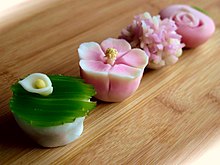 Nerikiri (練り切り) in various shapes and colors. Asian skunk cabbage, rose of Sharon, hydrangea, and rose. | |
| Type | Confectionery |
|---|---|
| Place of origin | Japan |
Wagashi (
Most of today's wagashi were born during the Edo period (1603-1868). This was a period of peace, economic and cultural prosperity, and increased domestic self-sufficiency in sugar.[2][3][4] During the Edo period, a series of delicate and beautiful fresh wagashi called nerikiri (練り切り) were created with various shapes and colors that characterize wagashi. Nerikiri are wagashi made by kneading white bean paste, gyūhi, sugar, yams, and other ingredients, and made in various colors and shapes based on seasonal flowers, animals, nature, events, customs, and other themes.[2][5]
Definition
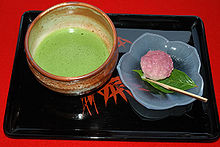
In Japan, the word for sweets or confectionery, kashi (菓子), originally referred to fruits and nuts.[6] Fruits and nuts may be eaten as snacks between meals and served as "sweets" during a tea ceremony.[7] The word Wa means "Japanese", and kashi becomes gashi in compound words, wagashi therefore means "Japanese confectionery".[7][8]
In 1603, the first year of the Edo period (1603-1868), the term kashi (菓子) meant both confectionery and fruit, and was more commonly used to refer to fruit. For example, the Japanese-Portuguese dictionary of the time describes "quaxi" (菓子) as "fruit, especially fruit eaten after a meal." The term mizugashi (水菓子, water confections), which is used to refer to fruit today, is a remnant of the same term.[3]
The word wagashi was coined at the end of 1800s to distinguish Japanese confectionery from sweets, cakes and baked goods introduced from the West termed yōgashi (洋菓子). However, wagashi was not the common term for Japanese confectionery until after the Second World War.[7]
The definition of wagashi is ambiguous, and the line between wagashi and other types of Japanese confectionery is vague. For example, although the original kasutera (castella) was introduced from Portugal, it has been around for more than 400 years and has been modified to suit Japanese tastes, so it is classified as a wagashi.[9][3][4] Mizu shingen mochi (水信玄餅, Raindrop cake), created in 2014, was developed by a wagashi shop as a derivative of shingen mochi and is recognized as a wagashi in Japan.[10][11] In recent years, wagashi shop have developed and marketed many confections that are an eclectic mix of wagashi and Western confections, often referred to as "neo-wagashi".[12]
History
Before the Edo period
Jomon - Nara period
It is believed that the first food eaten as a confection in Japan was a processed food from the
During the Yayoi period, dango (団子, dumpling) were made from grain or rice flour.[2]

During the
Heian - Muromachi period
The first beautifully crafted confections were created in the Heian period (794-1185) and are mentioned in The Tale of Genji under the names tsubakimochi (椿餅) and aosashi (青差).[2] Tsubakimochi was originally a confection that was not fried in oil, which was unusual among karakudamono, but it was later changed to suit the tastes of the Japanese people.[3] In the beginning, it was a mochi made by coating rice flour with a sweetener made from the juice of boiled vine grass and wrapping it in camellia leaves. Later, the sweetener made from the juice of boiled vine grass was replaced by sugar, and the rice cake was filled with red bean paste. Confectionery of this period was food offered to the nobility.[2]
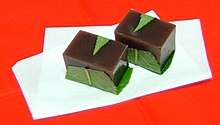
During the
Sengoku and Azuchi-Momoyama period
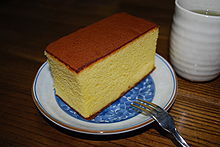
During the Sengoku period, the Portuguese brought Western confectionery to Japan through the Nanban trade. Kasutera (カステラ, castella) is a typical confection based on these Western confections. Kasutera was the only exception because it was made from chicken eggs, while Japanese confectionery was made from vegetable ingredients.[3][4] To suit their own tastes, the Japanese added mizuame (水飴) to the sponge cake to make it more moist, and zarame (ザラメ, coarse sugar), was added to the bottom of the sponge cake to give it a coarser texture.[17] As trade increased, so did sugar imports. The prototype of konpeitō (金平糖) was also brought to Japan through trade with Portugal and Spain.[4] While Kompeitō, introduced from Portugal, was a sugar-coated confection with a poppy seed or sesame seed center, the Japanese eventually transformed it into an all-sugar confection with a zarame (ザラメ, coarse sugar) center.[18]
From the Sengoku period to the
The dramatic development of wagashi and the establishment of modern wagashi

During the
Self-sufficiency in sugar increased when Tokugawa Yoshimune, the eighth Tokugawa shogun, encouraged the production of sugar.[2] In Sanuki Province, which is now Kagawa Prefecture, sugar called wasanbon (和三盆) was produced.[3] The common people began to eat wagashi that used a lot of sugar, and various types of wagashi were produced, especially in Kyoto. Local wagashi specialties began to be produced in various regions of Japan, and a wagashi culture blossomed throughout the country. The design of nerikiri (練り切り), a beautiful fresh confection with various shapes and colors that characterizes wagashi, was created and developed in Kyoto during this period and spread to all parts of Japan. The brand names and designs of these uniquely Japanese wagashi were compiled and recorded in picture books. The most famous of these is Onmushigashizu (御蒸菓子図), which lists the brand names and designs of wagashi from each period of the Edo period in color illustrations.[2][3]
The famous Kyoto wagashi Yatsuhashi (八ツ橋) was created in 1689 during the Genroku era (1688-1704) or in 1805 during the Bunka era (1804-1818). The name Yatsuhashi comes from a scene in the
Ame and amezaiku

During this time, ame (飴, candy) became popular with the common people. The ingredients of common people's sweets were often inexpensive grain-derived sweeteners rather than expensive sugar.[3] Ame was so popular that many people came up with creative ways to sell it. Peddlers sold ame by performing various tricks while walking the streets of the city, displaying karakuri puppet (traditional Japanese mechanized puppets), and dressing up as women. In the Kan'ei era (1624-1644), peddlers began selling a variety of wagashi to the general public in addition to ame.[3]
The production of amezaiku (飴細工, candy craft artistry), elaborate animal-shaped amezaiku, spread throughout the city beyond the previous temples along with the development of misemono (street performance).[21] The traditional Japanese scissors were indispensable for the production of amezaiku, and when the production of iron increased dramatically with the invention of the balance bellows in tatara iron manufacturing (たたら製鉄), the production of scissors also increased, contributing to the production of amezaiku. During the Bunka (1804-1818) and Bunsei era (1818-1830), it was possible to obtain amezaiku with the same shape as today's amezaiku.[22]
Japan's modernization and beyond
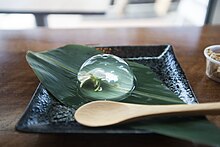
During the Meiji era (1868-1912), when Japan began active trade with the West after the end of its sakoku (鎖国, isolation policy), Western cooking utensils were brought to Japan. With the advent of the modern oven, many baked confections such as kuri manjū (栗饅頭, chestnut manjū) and kasutera manjū (カステラ饅頭, castella manjū) were born.[4]
In the 21st century, wagashi continues to be created. Nama yatsuhashi (生八ツ橋, unbaked or raw Yatsuhashi), created in 1960,[23] is a very popular souvenir of Kyoto. According to a survey conducted by the City of Kyoto in 2022, 89.2% of Japanese tourists who visited Kyoto bought souvenirs, of which 31.6% bought Nama yatsuhashi. This means that 42.3% of Japanese tourists who bought souvenirs in Kyoto in 2022 bought either Nama yatsuhashi or Yatsuhashi.[20]
In 2014, a wagashi shop in Yamanashi Prefecture created a mizu shingen mochi (水信玄餅, Raindrop cake) from kanten (agar) and water. The popularity of this wagashi has spread outside of Japan, and derivative products have been created.[24][10][11]
Types



- Akumaki: one of the confections of Kagoshima Prefecture
- kanten) served with sweet red bean paste and fruit
- azuki beans or other beans with sugar, and dried—amanattō and nattōare not related, although the names are similar.
- azuki bean paste)
- Daifuku: general term for mochi (pounded sweet rice) stuffed with anko
- Dango: a small, sticky, sweet Japanese dumpling, commonly skewered on a stick
- Domyoji: wagashi made with anko (red beans) wrapped in sticky rice
- Dorayaki: a round, flat sweet consisting of castella wrapped around anko
- Gokabou: a sweetened cake made of rice and mixed with sugar
- burdock), shaped like a flower petal
- Ikinari dango: a steamed bun with a chunk of sweet potato and anko in the center, it is a local confectionery in Kumamoto.
- Imagawayaki (also kaitenyaki): anko surrounded in a disc of fried dough covering
- Kompeito: crystal sugar candy
- Kusa mochi: "grass" mochi, a sweet mochi infused with Japanese mugwort (yomogi), surrounding a center of anko
- Kuzumochi
- Kuri kinton: a sweetened mixture of boiled and mashed chestnuts
- Manjū: steamed cakes of an surrounded by a flour mixture, available in many shapes such as peaches, rabbits, and matsutake (松茸) mushrooms
- Mochi: a rice cake made of glutinous rice
- Monaka: a center of anko sandwiched between two delicate and crispy sweet rice crackers
- Oshiruko(also zenzai): a hot dessert made from anko in a liquid, soup form, with small mochi floating in it
- Rakugan: a small, very solid and sweet cake which is made of rice flour and mizuame
- Sakuramochi: a rice cake filled with anko and wrapped in a pickled cherry leaf
- Taiyaki: like a imagawayaki, a core of anko surrounded by a fried dough covering, but shaped like a fish
- Uirō: a steamed cake made of rice flour and sugar, similar to mochi
- Yatsuhashi: thin sheets of gyūhi (sweetened mochi), available in different flavors, like cinnamon, and occasionally folded in a triangle around a ball of red anko
- Yōkan: one of the oldest wagashi, a solid block of anko, hardened with agar and additional sugar
- Yubeshi
Classification
There are several ways to classify wagashi, including classification by moisture content, ingredients, and production method. The most common classification method is based on moisture content, which is very important because it affects shelf life. According to this classification, sweets with a moisture content of 30% or more are classified as namagashi (wet confectionery), those with a moisture content of 10% to 30% are classified as han namagashi (half-wet confectionery), and those with a moisture content of less than 10% are classified as higashi (dry confectionery).[9][25]
When classified by production method, each type of wagahsi is classified as neri mono, which is made by kneading ingredients; mushi mono, which is made by steaming; yaki mono, which is made by baking; age mono, which is made by frying; nagashi mono, which is made by pouring ingredients into a mold; uchi mono, which is made by mixing powdered ingredients and sugar into a mold and then hardening the mixture; kake mono, which is made by pouring syrup over the ingredients; and ame mono, which is made by boiling down the sugar and hardening it, and so on.[9][25]
For example, yōkan can be classified as either namagashi (wet confectionery) or han namagashi (half-wet confectionery), depending on the product, as the moisture content varies from product to product. It is also classified as nagashi mono because it is made by pouring kanten (agar) into a mold and hardening it.[9][25]
- Namagashi (生菓子) (wet confectionery)—contains 30% or more moisture
- Jō namagashi (上生菓子) is a very soft and delicate, seasonally varying namagashi, in various, often elaborate, shapes and colors, often reflecting seasonal plants. Some stores will have many dozens over the course of a year.[26]
- Mochi mono (もち物)
- Mushi mono (蒸し物) (steamed confectionery)
- Yaki mono (焼き物) (baked confectionery)
- Hiranabe mono (平なべ物)(Flat pan baked confectionery)
- Ōbun mono (オーブン物) (oven baked confectionery)
- Nagashi mono (流し物)
- Neri mono (練り物)
- Age mono (揚げ物) (fried confectionery)
- Han namagashi (半生菓子) (half-wet confectionery)—contains 10%–30% moisture
- An mono (あん物)
- Oka mono (おか物)
- Yaki mono (焼き物) (baked confectionery)
- Hiranabe mono (平なべ物)(Flat pan baked confectionery)
- Ōbun mono (オーブン物) (oven baked confectionery)
- Nagashi mono (流し物)
- Neri mono (練り物)
- Higashi (干菓子) (dry confectionery)—contains 10% or less moisture
- Uchi mono (打ち物)
- Oshi mono (押し物)
- Kake mono (掛け物)
- Yaki mono (焼き物) (baked confectionery)
- Ame mono (あめ物) (candy confectionery)
See also
- Chinese desserts – Chinese confections
- Hangwa – Korean confections
- Bánh – Vietnamese sweet or savoury snacks and confections
- Turkish delight – Turkish confections
- List of Japanese desserts and sweets
- List of Japanese snacks
References
- ^ Harrison, Thom (2021). "What is 'Wagashi'?". Wagashi UK. Retrieved 25 April 2023.
- ^ a b c d e f g h i j 和菓子の歴史 (in Japanese). Ministry of Agriculture, Forestry and Fisheries (Japan). Archived from the original on 22 February 2024. Retrieved 22 February 2024.
- ^ a b c d e f g h i j k l m 駆け足でたどる和菓子の歴史 (in Japanese). National Diet Library. Archived from the original on 22 February 2024. Retrieved 22 February 2024.
- ^ a b c d e f g h i j その1和菓子の歴史 (in Japanese). Japan Wagashi Association. Archived from the original on 22 February 2024. Retrieved 22 February 2024.
- ^ 練り切り (in Japanese). Digitalio, Inc. Archived from the original on 4 March 2016. Retrieved 23 February 2024.
- ISBN 9780812235661. Retrieved Jan 30, 2013.
- ^ ISBN 9780199313396.
- ISBN 9781462924394.
- ^ a b c d その2和菓子の種類 (in Japanese). Japan Wagashi Association. Archived from the original on 16 February 2024. Retrieved 22 February 2024.
- ^ a b "賞味期限がたったの30分! 山梨でしか味わえない絶品「水信玄餅」は事前準備をしっかりして挑むべし!". Rocket news 24. 23 June 2021. Archived from the original on 28 February 2023. Retrieved 23 February 2024.
- ^ "「ネオ和菓子」脚光、小豆高騰". The Nikkei. 27 April 2023. Archived from the original on 26 April 2023. Retrieved 24 February 2024.
- ^ 縄文時代にクッキーがつくられていた? 縄文クッキーの謎 (in Japanese). Nippon Broadcasting System. 8 April 2018. Archived from the original on 8 July 2023. Retrieved 22 February 2024.
- ^ a b 羊羹の歴史について (in Japanese). Kaiundo. 28 January 2019. Archived from the original on 23 February 2024. Retrieved 22 February 2024.
- ^ 寒天 (in Japanese). Digitalio, Inc. 8 April 2018. Archived from the original on 23 February 2024. Retrieved 22 February 2024.
- ^ うどんとうんどん (in Japanese). 日本麺類業団体連合会/全国麺類生活衛生同業組合連合会. 8 April 2018. Archived from the original on 22 December 2022. Retrieved 24 February 2024.
- ^ 日本遺産 (Japan heritage) (PDF) (in Japanese). Nagasaki Prefecture. Archived from the original (PDF) on 23 February 2024. Retrieved 23 February 2024.
- ^ シュガーロードの砂糖文化とそのお菓子 (in Japanese). Independent Administrative Institution Agriculture & Livestock Industries Corporation. 11 July 2022. Archived from the original on 23 February 2024. Retrieved 23 February 2024.
- ^ "京のこだわり「伝統は法律より厳しい」八ツ橋創業年訴訟は続く". Sankei Business. 7 July 2020. Archived from the original on 1 November 2020. Retrieved 26 February 2024.
- ^ a b "観光客の動向等に係る調査" (PDF). Kyoto City. p. 45. Archived from the original (PDF) on 26 February 2024. Retrieved 26 February 2024.
- ^ Inaba, Chiho; Maruoka, Yukari; Ishikawa, Airi (13 February 2010). "Amezaiku". The Kyoto Project. Kyoto University of Foreign Studies. Archived from the original on 1 June 2023. Retrieved 13 February 2024.
- ^ "History of Amezaiku". amezaiku.com. 28 January 2019. Archived from the original on 23 February 2024. Retrieved 23 February 2024.
- ^ "なぜ老舗同士がトラブル?~京菓子「八ツ橋」騒動". Yahoo News Japan. 6 June 2018. Archived from the original on 15 February 2024. Retrieved 26 February 2024.
- ^ "Raindrop cake". Britannica. Archived from the original on 23 February 2024. Retrieved 23 February 2024.
- ^ a b c 和菓子の種類はどのくらい?分類方法や製法による特徴 (in Japanese). Hankyu Hanshin Department Stores. 3 April 2022. Archived from the original on 26 February 2024. Retrieved 26 February 2024.
- ^ Japanese Confectionery Gratifies the Eyes and the Palate Archived 2008-10-16 at the Wayback Machine Aichi Voice Issue 7, 1997
- Aoki, Naomi (October 2000). 図説 和菓子の今昔 Zusetsu wagashi no konjyaku. 株式会社淡交社 Tankosha Publishing Co., Ltd. ISBN 978-4-473-01762-8.
External links
- Japan Wagashi Association (in Japanese)
- Video of how it is made at YouTube
